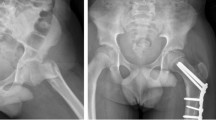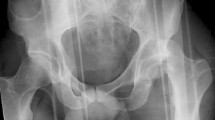Abstract
Fractures of the proximal femur and pelvis are rare in children but are associated with a high incidence of clinically significant complications which may present only after many years. These injuries are the result of high energy, blunt trauma although apophyseal avulsions are low energy sporting injuries.
Pelvic injuries are classified according to Torode and Zeig (Holden et al. J Am Acad Orthop Surg 15:172–7, 2007) although the ideal classification for paediatric injuries does not exist. The classification of proximal femoral fractures according to Delbet and cited by Colonna is prognostic by predicting the risk of avascular necrosis (AVN).
The anatomical differences of the developing hip and pelvis account for the different patterns of injury and unique complications seen in children. The pelvis is more malleable and greater energy is required to result in fracture than in the adult. The presence of the physis and large proportion of cartilage in the proximal femur renders it susceptible to growth arrest. Damage to the tri-radiate cartilage can lead to acetabular dysplasia. Until physeal closure, reliance of the proximal femoral epiphysis on end-arteries makes it susceptible to ischaemia with resultant AVN following injury.
Life-threatening haemorrhage is less common in children and mortality results from associated injuries sustained at the time of high energy trauma. After stabilisation of the patient as per trauma guidelines, injuries must be accurately assessed.
Plain radiography will reveal gross injuries although additional views, CT and MRI, may be required to detect more subtle changes, especially where fracture lines pass through unossified bone.
Fracture–dislocations of the proximal femur, displaced fractures or those with the potential to displace require operative management. Pelvic fractures were historically treated non-operatively due to perceived low morbidity and high remodelling potential in the younger patient. However, remodelling may be incomplete and a poor outcome relates to residual pelvic asymmetry. The treatment of pelvic injuries has therefore become more aggressive with a greater number of patients managed operatively. The indications for operative treatment of acetabular fractures are similar to those for adult patients.
The principles of management of hip fractures are anatomical reduction and stable fixation combined with capsular decompression. Closed reduction may be attempted but must not be accepted if imperfect. Open reduction is recommended via an anterior or anterolateral approach.
Internal fixation must be stable and more proximal fractures require threaded transphyseal devices at the expense of a potential growth arrest. However, smooth pins may suffice in the very young. Larger patients and more distal fractures may require a pin and side-plate system. Capsular decompression reduces the risk of AVN and is performed by open capsulotomy or large-bore needle aspiration.
Management of pelvic fractures is tailored to the age of the patient, the pattern and stability of the fracture. Fracture reduction can be achieved via closed manipulation, skeletal traction or open methods. Fixation methods are various and may involve combined internal and external fixation. Selective arterial embolisation may also be required to restore haemodynamic stability.
Post-operative care depends on the individual injury pattern, the quality of reduction, the stability of fixation and patient cooperation. Although AVN is usually detectable within 1 year of injury, patients must be followed up until skeletal maturity as the effects of growth disturbance and joint degeneration may only become apparent after many years.
Complications of proximal femoral fractures include AVN, coxa vara, growth arrest and leg-length discrepancy. The risk of AVN correlates with more proximal fractures, wide displacement and older patients in whom there is lower potential for re-vascularization and remodeling. A satisfactory outcome is difficult to achieve once AVN is established.
Pelvic injuries are associated with chronic pain, nerve injuries, urological problems, heterotopic ossification and pycho-social issues. Damage to the tri-radiate cartilage may cause acetabular dysplasia, incongruence and secondary joint degeneration.
Paediatric hip and pelvic fractures are challenging injuries that require a thorough understanding of the developing hip and pelvis to maximise future function.
Access this chapter
Tax calculation will be finalised at checkout
Purchases are for personal use only
Similar content being viewed by others
References
Boardman MJ, Herman MJ, Buck B, Pizztillo PD. Hip fractures in children. J Am Acad Orthop Surg. 2009;17:162–73.
Nayeemuddin M, Higgins GA, Bache E, O’Hara J, Glitheroe P. Complication rate after operative treatment of paediatric femoral neck fractures. J Pediatr Orthop B. 2009;18:314–9.
Holton C, Foster P, Templeton R. Fractures of the femoral neck in children. Curr Orthop. 2006;20:361–6.
Tang N, Cheng J. Decompression and stable internal fixation of femoral neck fractures in children can affect the outcome. J Pediatr Orthop. 1999;19(3):338–43.
Kaneko K, Mogami A, Nojiri H, Iwsai H, Kurosawa H, Okahara H, Niijima A. The effectiveness of magnetic resonance imaging for the proximal femoral ephyseal fracture (transepiphyseal fracture of the hip) in very young child. Eur J Orthop Surg Traumatol. 2001;11:251–3.
Babatur AE, Zorer G. Complications associated with surgically treated hip fractures in children. J Pediatr Orthop B. 2002;11(3):219–28.
Onstenk R, Van Eeckhoudt SJ, Bos CFA, Reinders ME, Aronson DC. Avascular necrosis of the head in paediatric hip fractures, an inevitable complication. Eur J Orthop Surg Traumatol. 2002;12:75–80.
Heeg M, Klasen H, Visser JD. Acetabular fractures in children and adolescents. J Bone Joint Surg Br. 1989;71-B:418–21.
Liporace FA, Ong B, Mohaideen A, Ong A, Koval KJ. Development and injury of the triradiate cartilage with its effects on acetabular development: review of the literature. J Trauma. 2003;54:1245–9.
Karunakar MA, Goulet JA, Mueller KL, Bedi A, Le TT. Operative treatment of unstable pediatric pelvis and acetabular fractures. J Pediatr Orthop. 2005;25(1):34–8.
Gordon RG, Karpik K, Hardy S, Mears DC. Techniques of operative reduction and fixation of paediatric and adolescent pelvic fractures. Oper Tech Orthop. 1995;5(2):95–114.
Subasi M, Arslan H, Necmioglu S, Onen A, Ozen S, Kaya M. Long-term outcomes of conservatively treated paediatric pelvic fractures. Inj, Int J Care Inj. 2004;35:771–81.
Holden CP, Holman J, Herman MJ. Pediatric pelvic fractures. J Am Acad Orthop Surg. 2007;15:172–7.
Azouz EM, Karamitsos C, Reed MH, Baker L, Kozlowski K, Hoeffel JC. Types and complications of femoral neck fractures in children. Pediatr Radiol. 1993;23:415–20.
Vitale MG, Kessler MW, Choe JC, Hwang MW, Tolo VT, Skaggs DL. Pelvic fractures in children, an exploration of practice patterns and patient outcomes. J Pediatr Orthop. 2005;25(5):581–7.
Shrader MW, Jacofsky DJ, Stans AA, Shaughnessy WJ, Haidukewych GJ. Femoral neck fractures in pediatric patients. Clin Orthop Relat Res. 2006;454:169–73.
Mormor M, Matityahu A. Surgical treatment of an acetabular fracture and labral tear with suture anchors in a 10-Year-old child. Orthopedics. 2009;32(11):854.
Smith W, Shurnas P, Morgan S, Agudelo J, Luszko G, Knox EC, Georgopoulos G. Clinical outcomes of unstable pelvic fractures in skeletally immature patients. J Bone Joint Surg Am. 2005;87:2423–31.
Jones JCW, Feldman KW, Bruckner JD. Child abuse in infacnts with proximal physeal injuries of the femur. Pediatr Emerg Care. 2004;20(3):157–61.
Vandervliet EJM, Vanhoenacker FM, Snoeckx A, Gielen JL, Van Dyck P, Parizel PM. Sports -related acute and chronic avulsion injuries in children and adolescent s with special emphasis on tennis. Br J Sports Med. 2007;41:827–31.
Sundar M, Carty H. Avulsion fractures of the pelvis in children: a report of 32 fractures and their outcome. Skeletal Radiol. 1995;23:85–90.
Rossi F, Dragoni S. Acute avulsion fractures of the pelvis in adolescent competitive athletes: prevalence, location and sports distribution of 203 cases collected. Skeletal Radiol. 2001;30:127–31.
Stevens MA, El Khoury GY, Kathol MH, Brandsen EA, Chow S. Imaging features of avulsion injuries. J Cont Med Educ Radiol. 1999;19:655–72.
McKinney BI, Nelson C, Carrion W. Apophyseal avulsion fractures of the hip and pelvis. Orthopedics. 2009;32(1):42–9.
Moon ES, Mehlman CT. Risk factors for avascular necrosis after femoral neck fractures in children: 25 cincinnati cases and meta-analysis of 360 cases. J Orthop Trauma. 2006;20(5):323–9.
Quick TJ, Eastwood DM. Pediatric fractures and dislocations of the hip and pelvis. Clin Orthop Relat Res. 2005;432:87–96.
Moeller JL. Pelvic and hip apophyseal avulsion injuries in young athletes. Curr Sports Med Rep. 2003;2:110–5.
Brittenden J, Robinson P. Imaging of pelvic injuries in athletes. Br J Radiol. 2005;78:457–68.
Maeda S, Kita A, Fujii G, Funayama K, Yamada N, Kokubun S. Avascular necrosis associated with fractures of the femoral neck in children: histological evaluation of core biopsies of the femoral head. Inj, Int J Care Inj. 2003;34:283–6.
Ng GPK, Cole WG. Effect of early hip decompression on the frequency of avascular necrosis in children with fractures of the neck of the femur. Injury. 1996;27(6):419–21.
Author information
Authors and Affiliations
Corresponding author
Editor information
Editors and Affiliations
Rights and permissions
Copyright information
© 2014 EFORT
About this entry
Cite this entry
Hawkins, R., Al-Khateeb, H., Hashemi-Nejad, A. (2014). Paediatric Hip and Pelvic Trauma. In: Bentley, G. (eds) European Surgical Orthopaedics and Traumatology. Springer, Berlin, Heidelberg. https://doi.org/10.1007/978-3-642-34746-7_166
Download citation
DOI: https://doi.org/10.1007/978-3-642-34746-7_166
Published:
Publisher Name: Springer, Berlin, Heidelberg
Print ISBN: 978-3-642-34745-0
Online ISBN: 978-3-642-34746-7
eBook Packages: MedicineReference Module Medicine




